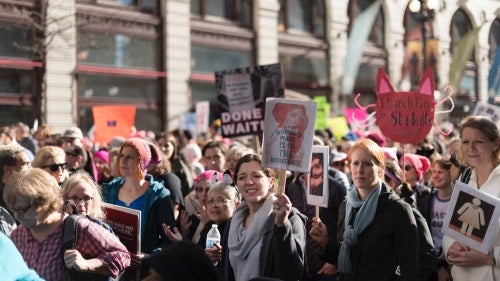National Elections and the New American City-State

As the country splinters along geographic and ideological lines, post-election divisions could portend the rise of a new American city-state movement.
America’s 2016 presidential election marks a turning point in the relationship between local and federal government. The Electoral College will soon reverse the national popular vote for only the fifth time in history, favoring a candidate who was largely rejected by urban voters. As the country splinters along geographic and ideological lines, post-election divisions could portend the rise of a new American city-state movement, with mayors and city councils likely to intensify efforts to independently pursue progressive local agendas. Rather than prepare for battle, however, the city-state movement should broaden its relevance to rural areas in order to make a convincing case for the international economic, cultural, and social unity fueling its growth.
The United States is urbanizing at a steady pace, with a majority of population growth occurring in cities. In the 2016 election, however, votes in states with larger, more urban populations effectively counted less than those in states with smaller, less urban populations. For example, a Wall Street Journal study calculated that Wyoming voters “wielded almost three times as much influence as California voters.” Due in part to the fact that smaller states have more Electoral College votes per voter than do large states, the candidate who overwhelmingly won urban areas (and the national popular vote by roughly 2.5 million votes) will not be the country’s next president.
This phenomenon has prompted scholars, analysts, and media to ask probing questions about the democratic legitimacy of the Electoral College system. One notable corollary is that states with large cities have less political influence relative to their importance in the national economy. Rural areas, no longer America’s primary economic engines, enjoy a degree of influence that out-scales their modest population size and economic contribution. As the dust settles and people come to terms—happily or otherwise—with the finality of the election, now is the time to consider how the rural-urban political divide will impact America’s cities.
This rural-urban divide in the United States—an increasingly global phenomenon—is pitting city leadership against national leadership on a variety of issues, with major cities already publicly disavowing policies that impede metropolitan economic growth and threaten the well-being of urbanites. By early indications, the incoming administration is at ideological odds with cities on issues such as immigration, economic inequality, climate change, social support, gun control, and policing, among others. In a recent speech, New York City Mayor Bill de Blasio vowed to resist any federal policy deemed discriminatory, stating “we will use all the tools at our disposal to stand up for our people.”
The city-state movement could redefine the longstanding local-national balance of power. Indeed, the movement’s rebranding of “home rule” portends a new generation of rebellious governance in which openness, social tolerance, and economic progressivism endure only in America’s largest and most economically consequential cities – despite contempt from national administrations. To remain globally competitive, these cities will need to maintain their welcoming international image and distance themselves from rhetoric of fear and isolation.
The emerging city-state movement may appear little more than a reincarnation of the “states’ rights” movement; both share a spirit of autonomy. The difference, however, is decidedly ideological. The concept of “states’ rights” has historically been invoked to resist federal civil rights legislation, dividing communities and perpetuating oppression. By contrast, the city-state movement seems unified in opposition to division and oppression. The tug-of-war between state and national authority has persisted for decades on divisive issues such as abortion and, more recently, voting rights, drug policy, criminal justice reform, and LGBT rights. It is clear that progressive causes have little currency in America’s rural “heartland.” Some Democratic commentators argue that the election was lost, in part, because the “coastal” progressive movement focuses too much on social issues and not enough on working class employment.
Each generation appears to have its own policy-based urban-rural divide, which across time highlights a structural problem in how demographic and social change is politically reconciled with the lingering legacy of American agrarian conservatism. Combining disparate issues such as marriage equality and blue-collar job losses into a coherent narrative about social justice is a challenging but potentially transformative strategy to unify urban and rural areas – particularly against what many label a discriminatory and economically predatory elite. Ultimately, the marketplace of ideas will reward the movement that applies substantive and sensible policy.
Accelerating urbanization, increasing ethnic diversity, and more tolerant social attitudes among younger generations presage the gradual but inevitable liberalization of the American electorate. The most recent election result may be viewed in time as an aberration, but still must be taken as a call to action for both national party leaders and city governments. While the urban-rural divide deserves analysis, emphasizing it as an ideological battle front is limiting; finding common ground should be prioritized. As such, the triumph of a characteristically “urban” ideology is not the end game. The ability of all citizens to pursue happiness without discrimination is the highest calling, and this ideal seems at the moment to be embraced more fully by the urban electorate. The city-state movement must broaden its relevance. Ideals of democracy and equality should know no geographic boundary, and a resurgent rural progressivism would provide valuable allyship.
Finally, the global implications of domestic political dynamics can and should shape the practical proposals of the city-state movement. As the world’s “strong-man” authoritarians consolidate and strengthen their domestic power, the last hope for international economic, cultural, and social unity and stability is the strength of city-to-city ties across borders, particularly among global cities. The fate of America’s domestic city-state movement rests in its ability to make a convincing case against global isolation and fear by appealing to both the moral and economic sensibilities of all voters, urban and rural. In what is likely to be a politically contentious four years, many Americans will look to city-states and their leaders as champions of humanitarian decency and economic pragmatism.

